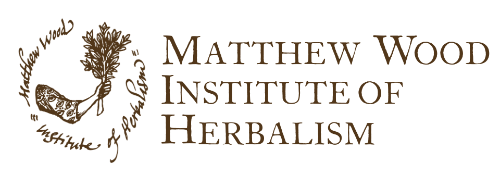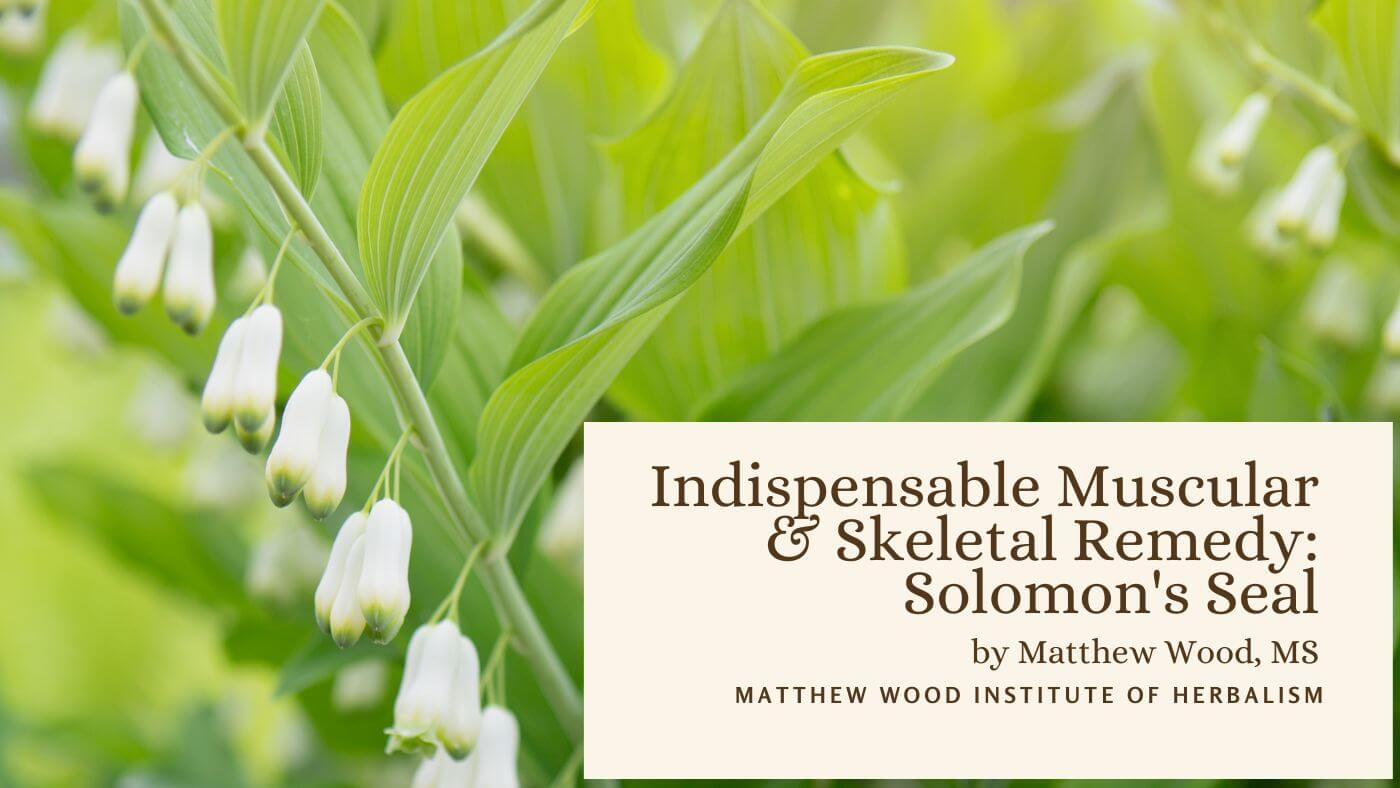VII. The Indispensable Muscular and Skeletal Remedy.
Men and women are subject to injury of the locomotive system upon which they rely for movement. Thus, we must be able to repair damage to the connective tissue – bones, cartilage, joints – and true Solomon’s seal is the best.
Polygonatum spp. True Solomon's Seal.
Solomon’s Seal is a member of the lily family. Various spp. are native to Asia, Europe, and North America, where they have been used as food and medicine. The soft, sweet white/yellowish rhizomes look like bones and vertebrae, while the leaves wrapping around the stalk look like tendons and ligaments wrapping around bones, so Polygonatum has been used to strengthen the bones, marrow, and tendons. The “seals” on the rhizomes, where the stalk rises up, look like the sigils used by magicians (circles with marks inside them). Hence, the plant was named sigilum Salomanis or Solomon’s seal, after the wise king. It is one of the plants known in Afro-American herbalism as ‘High John the Conqueror,’ in reference to magic or ‘conquering.’ It is worn as a mojo or chewed for ‘conquering.’
True Solomon’s Seal is used in Asia, Europe, and North America as a sweet nutritive for tendons and joints. It is of such widespread utility that it can help almost anyone with muscular and skeletal problems. It also has a beneficial demulcent nutritive influence to soothe the irritation of the mucosa, hence it can be helpful in the lungs, gastrointestinal tract, and female system. The rhizomes look like bones, knuckles, and vertebrae, the leaves clasp around the stem, looking like a muscle attaching to a bone, and the flowers appear at the joints. Solomon’s seal also is considered to have a tonifying effect on the sexual system, both male and female. It contains small amounts of cardiac glycosides, like its cousin Convallaria majalis (lily of the valley), but not enough to make it a toxic plant. Indeed, it was an important article of the American Indian diet and remains today a trail food.
Polygonatum spp. is used in Chinese herbalism, where it is known as ‘yellow essence.’ It is classified as a sweet, neutral yin tonic, or moistening, lubricating, and nourishing tonic. It lubricates the heart and lungs, tones the middle region (abdomen), builds the marrow, and increases semen (essence). As a yin deficiency tonic it is used for dry throat and thirst, cough due to dry lungs, diabetes, and grey hair from kidney yin deficiency. Modern research shows that it can be used to bring down high blood pressure, protect the liver, treat fatty liver, reduce blood sugar levels, and blood fat (Lu, 1994, 203).
Taste: sweet, slightly acrid, cool, moist
Tissue State: atrophy
Specific Indications
Constitution, Complexion, Characteristic Symptoms
Respiratory
Cardiovascular
Digestive
Female
Male
Muscular and Skeletal
External
Preparation and dosage: The rhizomes are collected in the fall, dried for use by decoction, or extracted fresh in alcohol. High-proof alcohol has to be used since the sticky roots cause a sweet syrup if extracted in a low-proof sweet alcohol like brandy. They can also be extracted in rubbing alcohol (add Apios for extra effect, Native American formula).
Dose: external or internal use in small to large amount.
Contra-indications: The berries are considered toxic, though I know of one person who eats quite a few to test this ancient idea and suffered no adverse effects. Environmentally challenged in some areas.
Looking to learn more about topics in this blog? Check out these great A-Z Herbal Classes.
"In a busy practice covering over twenty-five years and tens of thousands of clients, a person learns what remedies are of invaluable service. I would like to share my selection – herbs I choose and herbs that choose me."
Polygonatum spp. True Solomon's Seal.
Solomon’s Seal is a member of the lily family. Various spp. are native to Asia, Europe, and North America, where they have been used as food and medicine. The soft, sweet white/yellowish rhizomes look like bones and vertebrae, while the leaves wrapping around the stalk look like tendons and ligaments wrapping around bones, so Polygonatum has been used to strengthen the bones, marrow, and tendons. The “seals” on the rhizomes, where the stalk rises up, look like the sigils used by magicians (circles with marks inside them). Hence, the plant was named sigilum Salomanis or Solomon’s seal, after the wise king. It is one of the plants known in Afro-American herbalism as ‘High John the Conqueror,’ in reference to magic or ‘conquering.’ It is worn as a mojo or chewed for ‘conquering.’
True Solomon’s Seal is used in Asia, Europe, and North America as a sweet nutritive for tendons and joints. It is of such widespread utility that it can help almost anyone with muscular and skeletal problems. It also has a beneficial demulcent nutritive influence to soothe the irritation of the mucosa, hence it can be helpful in the lungs, gastrointestinal tract, and female system. The rhizomes look like bones, knuckles, and vertebrae, the leaves clasp around the stem, looking like a muscle attaching to a bone, and the flowers appear at the joints. Solomon’s seal also is considered to have a tonifying effect on the sexual system, both male and female. It contains small amounts of cardiac glycosides, like its cousin Convallaria majalis (lily of the valley), but not enough to make it a toxic plant. Indeed, it was an important article of the American Indian diet and remains today a trail food.
Polygonatum spp. is used in Chinese herbalism, where it is known as ‘yellow essence.’ It is classified as a sweet, neutral yin tonic, or moistening, lubricating, and nourishing tonic. It lubricates the heart and lungs, tones the middle region (abdomen), builds the marrow, and increases semen (essence). As a yin deficiency tonic it is used for dry throat and thirst, cough due to dry lungs, diabetes, and grey hair from kidney yin deficiency. Modern research shows that it can be used to bring down high blood pressure, protect the liver, treat fatty liver, reduce blood sugar levels, and blood fat (Lu, 1994, 203).
Taste: sweet, slightly acrid, cool, moist
Tissue State: atrophy
Specific Indications
Constitution, Complexion, Characteristic Symptoms
- Stretched, stiff, tight, or loose, weak tendons and ligaments.
- Nutritive food for weak and prostrated persons; tuberculosis.
- Irritation of the mucosa of the intestines, lungs, vagina.
Respiratory
- Pulmonary problems and hemorrhages.
Cardiovascular
- Heart; relaxes, increases the space between the beats.
Digestive
- Intestinal upset; tension.
- Hemorrhoids.
Female
- Profuse menstrual flow, vaginal irritation.
- Restores hormonal glow to the face, tonifies the ovaries, strengthens the estrogen side of the cycle.
- Ovarian pain.
Male
- Premature ejaculation.
Muscular and Skeletal
- Muscular and skeletal tensions, and bone spurs resulting from such tensions.
- Repetitive use injury; carpel tunnel syndrome; arthritis associated with old injuries, calcifications, and muscular and skeletal tensions.
External
- Bruises.
- External on poison ivy.
Preparation and dosage: The rhizomes are collected in the fall, dried for use by decoction, or extracted fresh in alcohol. High-proof alcohol has to be used since the sticky roots cause a sweet syrup if extracted in a low-proof sweet alcohol like brandy. They can also be extracted in rubbing alcohol (add Apios for extra effect, Native American formula).
Dose: external or internal use in small to large amount.
Contra-indications: The berries are considered toxic, though I know of one person who eats quite a few to test this ancient idea and suffered no adverse effects. Environmentally challenged in some areas.
Looking to learn more about topics in this blog? Check out these great A-Z Herbal Classes.
"In a busy practice covering over twenty-five years and tens of thousands of clients, a person learns what remedies are of invaluable service. I would like to share my selection – herbs I choose and herbs that choose me."
References
Traditional, Gerard (1, 2, 12, 14), William Cook (3), Matthew Wood (1, 3, 5, 6, 12, 13), Henry Lu (11), Julia Graves (9, 10), William Cullen (7), Chalid Ottway, Matthew Cameron (2, 4).
Selections from The Earthwise Herbal By Matthew Wood MS published by North Atlantic Books, in two volumes, 2008-9
Traditional, Gerard (1, 2, 12, 14), William Cook (3), Matthew Wood (1, 3, 5, 6, 12, 13), Henry Lu (11), Julia Graves (9, 10), William Cullen (7), Chalid Ottway, Matthew Cameron (2, 4).
Selections from The Earthwise Herbal By Matthew Wood MS published by North Atlantic Books, in two volumes, 2008-9
**Disclaimer**
The information provided in this digital content is not medical advice, nor should it be taken or applied as a replacement for medical advice. Matthew Wood, the Matthew Wood Institute of Herbalism, ETS Productions, and their employees, guests, and affiliates assume no liability for the application of the information discussed.
The information provided in this digital content is not medical advice, nor should it be taken or applied as a replacement for medical advice. Matthew Wood, the Matthew Wood Institute of Herbalism, ETS Productions, and their employees, guests, and affiliates assume no liability for the application of the information discussed.


